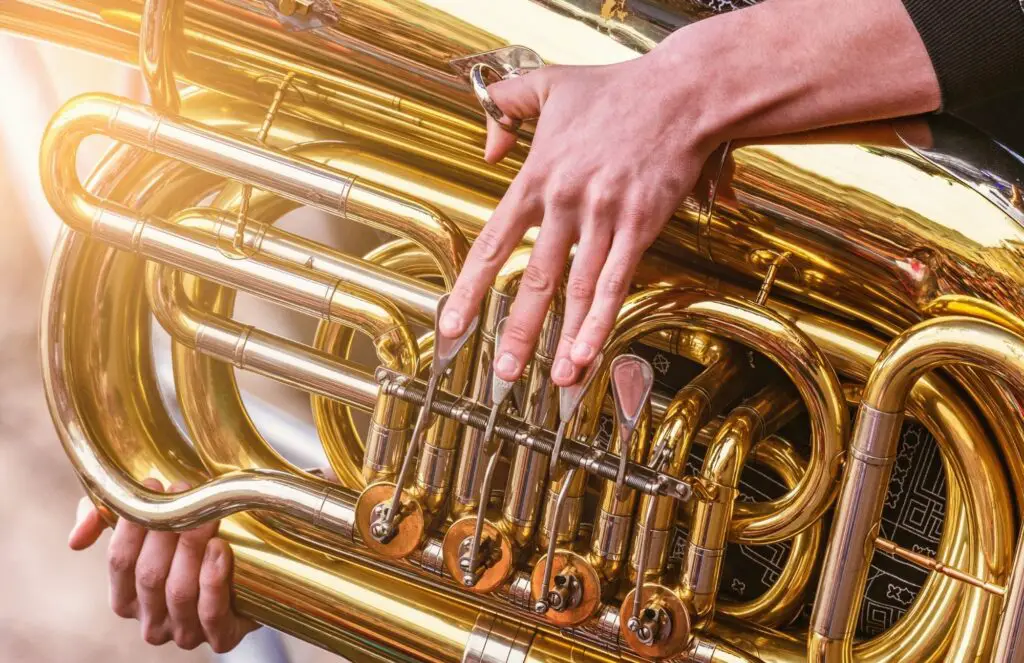If you’re a musician, then you’ve probably heard of conical and cylindrical bore instruments. And by the name you can probably guess the general shape that each means…but I wanted to do a deeper dive in to these two terms and give some instruments examples as well as sound characteristic descriptions. But first, what’s the difference between conical and cylindrical bore instruments?
In general, the difference between conical and cylindrical bore instruments is the shape of the instrument. Cylindrical bore instruments have a consistent diameter whereas conical bore instruments start with a small opening at the mouthpiece and gradually get larger until it reaches the bell.

All woodwind and brass instruments in a standard band or orchestra will fit into one of these two categories…except the tuba, it has to do its own thing. More on that below!
What Does Conical Bore Mean?
Generally, conical bore means cone shaped. The diameter of the instrument starts smaller towards the mouthpiece and gradually widens towards the bottom of the instrument, just before the bell flair.
Don’t mistake the bell flair of an instrument with automatically making it conical in shape. Instruments, such as the trumpet, have a pronounced bell flair but are still considered cylindrical bore instruments.
The bell flair on an instrument is meant to increase the projection of sound and intonation for certain instruments.
What Are The Sound Characteristics Of A Conical Bore Instrument?
On average, conical bore instruments have less resistance for the air to travel through the instrument, giving it a brighter and more open sound. In addition, conical bore instruments usually have more overtones.
A quick note on overtones and partials since they do a lot to create the sound (timbre) of an instrument. Thanks to it’s cone-like shape, conical bore instruments have what’s called a harmonic series. This means that conical bore instruments have a lot of overtones, or upper partials.
You can think of it like this – If the fundamental note is ‘C’, conical bore instruments will also naturally produce a ‘C’ an octave above, as well as a ‘G’ above that, and so on. This gives conical bore instruments a lot of color and richness in their sound that cylindrical bore instruments don’t have.
Examples of Conical Bore Instruments
- Bugle
- French Horn
- Bassoon
- Euphonium
- Flugelhorn
- Conch Shell
- Oboe
- Saxophones
- Uilleann Pipes
While the vast majority of conical bore instrument will taper from smaller towards the mouthpiece to wider towards the bell, there is an exception to this.
Baroque era recorders were built with a reverse taper, meaning that it did have a conical bore, but it started wider at the mouthpiece and thinned towards the end of the instrument.
What Does Cylindrical Bore Mean?
Cylindrical bore instruments have a cylindrical shape throughout the majority of the instrument. This means that the diameter of the instrument is the same size from the mouthpiece to the bell flair.
Once again I need to mention bell flair. Bell flair is not taken into account when considering if an instrument is cylindrical or conical.
Clarinets, for example, have a bell flair but are considered cylindrical bore instruments, whereas bassoons have no prominent bell flair and are considered conical.
What Are The Sound Characteristics Of A Cylindrical Bore Instrument?
In general, cylindrical bore instruments have a more focused and dark sound as well as fewer overtones. This is because cylindrical bore instruments have more resistance for the air to travel through the instrument.
Many woodwind instruments have a cylindrical bore and indeed have a more focused sound that I mentioned above. Of course, the material the instruments are made of also affect the tone quality of an instrument, but it’s amazing how much bore size can change the sound characteristics of an instrument.
Examples of Cylindrical Bore Instruments
- Trumpet
- Trombone
- Clarinets
- Flute
- Piccolo
- Recorders (mainly modern versions)

Are There Instruments That Don’t Fit The Standard Conical Or Cylindrical Definition?
There are a few instruments that don’t fit perfectly into either the conical or cylindrical bore categories. The most notable examples are the tuba and the sousaphone which have what’s called a conical-cylindrical bore.
In order to accommodate the valve portion of the instrument, tubas and sousaphones have a section of tubing that is cylindrical. So the instruments start with conical shaped bores, have a section of cylindrical bore, and then finish with more conical tubing.
Is The Pipe Organ Considered A Cylindrical Bore Instrument??
The pipe organ is a conical bore instrument, however, the conical shape is not as pronounced as other conical instruments. The vast majority of the tubing in a pipe organ is cylindrical with only a small section being conical.
This is because most of the sound in a pipe organ comes from the flue pipes which are cylindrical. The conical shape is mainly for the reed pipes which create a small percentage of the overall sound in a pipe organ.
I debated on including the pipe organ in this article since the terms conical and cylindrical bore are mostly associated with woodwind and brass instruments. However, some of the research I found convinced me that pipe organs could also fit into the spirit of this article.
Final Thoughts
I hope this article helped clear up any confusion you had about conical and cylindrical bore instruments.
For the most part, it really doesn’t matter whether or not you know which instruments are conical and which are cylindrical…but if you are a composer or a sound designer then knowing how and why certain instruments make the sounds that they do, it’s a topic worth looking into.
